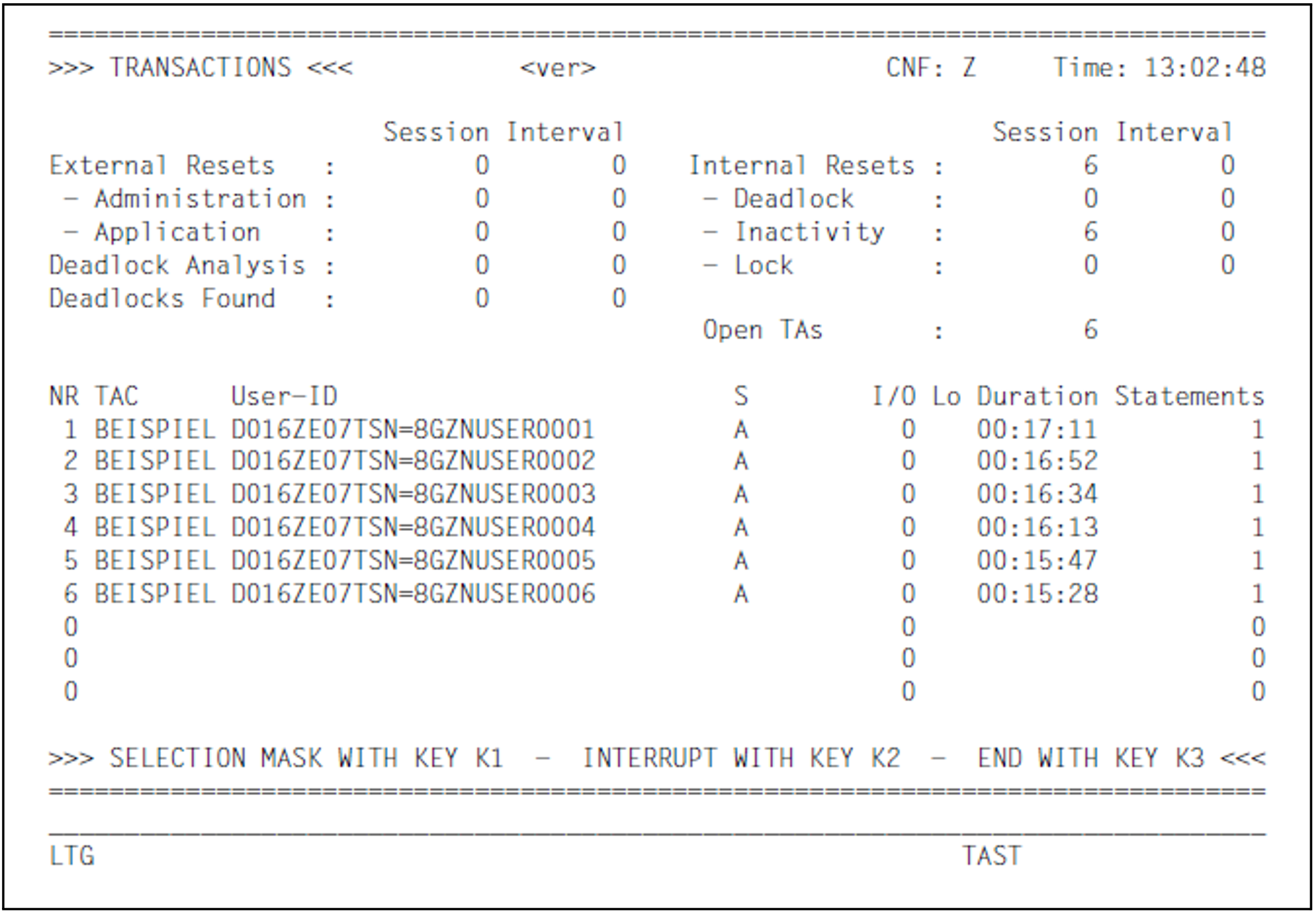This form provides information on the state and behavior of transactions.
Field descriptions
<ver> CNF Time | SESDCN version. Name of the configuration monitored. Time at which the form is output. |
External Resets
Number of transactions rolled back by means of administration commands or statements or a statement in the application program (in this SESDCN session and per time period)
Administration
Number of transactions rolled back by means of administration commands or statements (in this SESDCN session and per time period)
Application
Number of transactions rolled back by means of a statement in the application program (in this SESDCN session and per time period)
Deadlock Analysis
Number of deadlock analyses carried out (in this SESDCN session and per time period)
Deadlocks Found
Number of deadlock analyses in which deadlocks were detected (in this SESDCN session and per time period)
Internal Resets
Number of transactions rolled back for internal reasons (in this SESDCN session and per time period). Internal reasons for this are deadlock or the inactivity time (“Inactivity”) or lock time (“Lock”) being exceeded.
Deadlock
Number of transactions rolled back because of deadlock (in this SESDCN session and per time period)
Inactivity
(field name in the case of output to SYSLST: NATL)
Number of transactions rolled back because the inactivity time has been exceeded (in this SESDCN session and per time period). You set the inactivity time by means of the INACTIVITY-TIME parameter of the DCN option SYSTEM-LIMITS.
Lock
(field name in the case of output to SYSLST: LCTL)
Number of transactions rolled back because the lock time has been exceeded (in this SESDCN session and per time period). You set the lock time by means of the LOCK-TIME parameter of the DCN option SYSTEM-LIMITS.
Open TAs
Number of currently open transactions
The following information relates to individual transactions. The transactions are sorted in descending order according to their duration. A maximum of nine transactions are output.
NR
Unique (two-digit) transaction number assigned by SESMON.
TAC
UTM transaction code used to call the application program that opened this transaction (eight characters).
In the case of TIAM applications, the user ID of the application program appears here, in the case of DCAM applications the request name.
User-ID
Identification of the user who opened the transaction (32 characters). It is output in 32 positions in the following form: HOST-NAME, APPLICATION-NAME, CUSTOMER-NAME, CONVERSATION-ID (see "Syntax for the identification of users")
S (State)
State of the transaction (one character):
A: active
P: Prepare-To-Commit
L: locked
I/O
Weighted sum of the physical inputs and outputs of this transaction. The weighted sum is obtained by counting write accesses twice and read accesses once.
Lo (Lock)
Number of the transaction locking this transaction (2 digits). If the output transaction is locked by a transaction that can no longer be displayed on the screen, this is indicated by two asterisks (**).
Duration
Elapsed time of the transaction in the form hh:mm:ss.
Statements
Number of statements of this transaction that have been executed. Only those statements that have not been processed completely by the SQL runtime system are counted. In cases where CALL DML statements are chained, each individual statement is counted.

